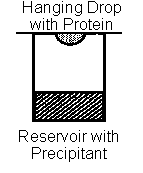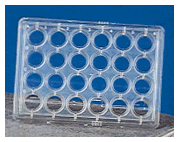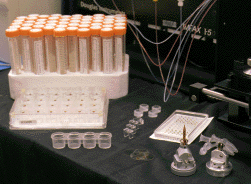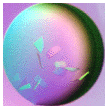 How to
grow protein crystals
How to
grow protein crystals How to
grow protein crystals
How to
grow protein crystals
We all are familiar with crystals from rock collections or small molecules, such as salt or sugar. We usually associate them with properties like hard, durable, and pretty. Unfortunately, only the latter is true for protein crystals.
Proteins
Proteins consist of long macromolecule chains made up from
20 different amino acids. The chains can be several hundred residues long and fold into a
3-dimensional structure. It is therefore quite understandable that protein molecules have
irregular shapes and are not ideally suited to be stacked into a periodic lattice, i.e., a
crystal. Protein crystals are thus very fragile, soft (think of a cube of jelly instead of
a brick) and sensitive to all kind of environmental variations. Protein crystals
contain on average 50% solvent, mostly in large channels between the stacked
molecules on the crystal. The interactions holding the molecules together are
usually weak, hydrogen binds, salt bridges, and hydrophobic interactions,
compared to strong covalent or ionic interactions in mineral crystals.
This explains the fragility of the crystals, but allows for the possibility of soaking
metal solutions (important for phasing)
or even large enzyme substrates or inhibitors, into the
crystals.
The Experimental Setup
In order to obtain a crystal, the protein molecules must
assemble into a periodic lattice. One starts with a solution of the protein with a fairly
high concentration (2-50 mg/ml) and adds reagents that reduce the solubility close to
spontaneous precipitation. By slow further concentration, and under conditions suitable
for the formation of a few nucleation sites, small crystals may start to
grow. Often very many conditions have to be tried to succeed. This is usually done by initial screening, followed by a systematic optimization of
conditions Crystals should to be a few tenth of a mm in each direction to be useful for
diffraction experiments.



Right : The hanging drop technique. Center : 24 such hanging drop experiments are set up in a Linbro plate. Right : A kit of different screening solutions, a set-up Linbro plate, dialysis buttons and a micro batch plate behind a goniometer head.
The most common setup to grow protein crystals is by the hanging drop technique : A few microliters of protein solution are mixed with an about equal amount of reservoir solution containing the precipitants. A drop of this mixture is put on a glass slide which covers the reservoir. As the protein/precipitant mixture in the drop is less concentrated than the reservoir solution (remember: we mixed the protein solution with the reservior solution about 1:1), water evaporates from the drop into the reservoir. As a result the concentration of both protein and precipitant in the drop slowly increases, and crystals may form. There is a variety of other techniques available such as sitting drops, dialysis buttons, and gel and microbatch techniques. Robots are useful for automatic screening and optimization of crystallization conditions. We have implemented a web computing service of Brent Segelke's CRYSTOOL, an inherently efficient random screen for crystallization conditions that you can customize. The main advantage is the small sample size a crystallization robot can handle reproducibly, but it needs some effort to set it up. Click here to learn more about the IMPAX-II robot.
Physical chemistry of crystallization
To learn more about the theory behind phase relations used in protein crystallization [pathway diagrams, got to my EMBL lecture notes (this is heavy stuff).
To learn more about tricks and supplies for crystal growing click here

Helpful techniques to screen proteins
The chances for success in crystallizaion experiments depend strongly on the
conformational purity of a protein. A single band on a denaturing SDS gel is a good sign, but Dynamic Light Scattering and Circular Dichroism help to learn about
the aggregation and dispersity or the folding of your protein sample. Follow the links for
more.
A great picture tour of our crystallization lab!
 Crystals in a hanging drop
Crystals in a hanging drop
Click here to continue the X-ray tutorial
![]() Mark's Practical
Crystallization Tips
Mark's Practical
Crystallization Tips
![]() Back to X-ray Tutorial Introduction
Back to X-ray Tutorial Introduction
LLNL Disclaimer
This World Wide Web site conceived and maintained by
Bernhard Rupp (br@llnl.gov)
Last revised March 05, 2004 14:55
UCRL-MI-125269